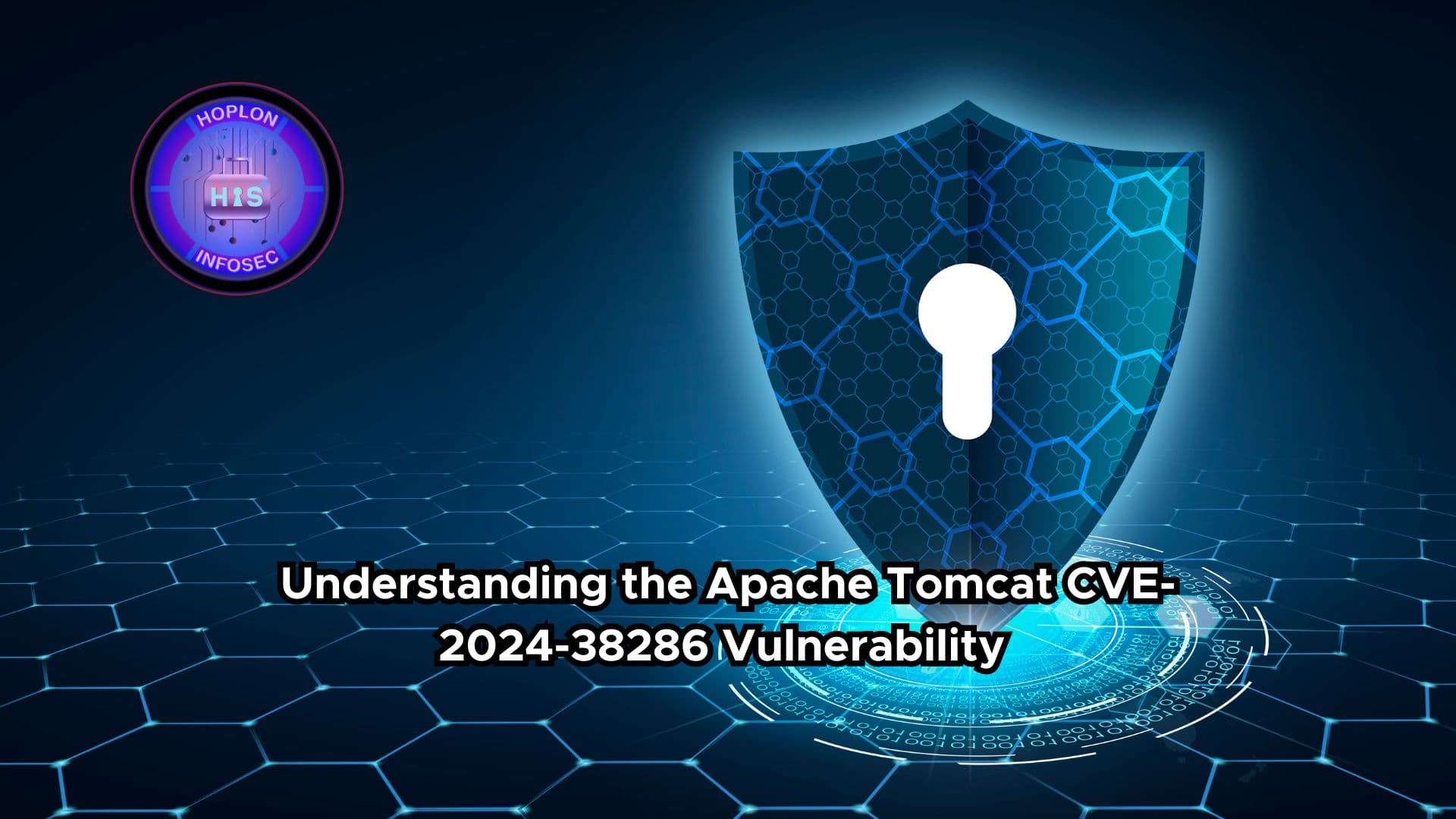Understanding the Apache Tomcat CVE-2024-38286 Vulnerability

Hoplon InfoSec
24 Sep, 2024
A newly discovered vulnerability in Apache Tomcat, identified as CVE-2024-38286, has raised significant concerns within the cybersecurity community. This vulnerability allows attackers to exploit the TLS handshake process, potentially triggering a Denial of Service (DoS) attack. In this blog, we will explore the details of this vulnerability, its implications, and the necessary steps organizations must take to mitigate risks.
What is Apache Tomcat?
Apache Tomcat is a widely used open-source application server that implements the Java Servlet, JavaServer Pages, and Java Expression Language specifications. It is an essential component for many enterprise applications that rely on Java. Given its prevalence, vulnerabilities within Tomcat can have substantial implications for organizations that depend on it for application delivery and performance.
Overview of CVE-2024-38286
What the Vulnerability Entails
CVE-2024-38286 is classified as an “Important” severity vulnerability. It affects various versions of Apache Tomcat, allowing attackers to exploit weaknesses in the TLS handshake process. The Apache Software Foundation has confirmed that under certain configurations, attackers can trigger an OutOfMemoryError, which leads to a Denial of Service condition. This can significantly impair the performance and availability of applications running on affected versions.
Affected Versions
The following versions of Apache Tomcat are impacted by this vulnerability:
- Apache Tomcat 11.0.0-M21 and earlier
- Apache Tomcat 10.1.25 and earlier
- Apache Tomcat 9.0.90 and earlier
Organizations using any of these versions must take immediate action to protect their systems.
How the Vulnerability Works
The TLS Handshake Process
The TLS handshake is a critical part of establishing a secure connection between a client and a server. It involves a series of steps where both parties authenticate each other and agree on encryption protocols. In the case of CVE-2024-38286, attackers can manipulate this handshake process by sending specially crafted requests. These requests can cause the server to consume excessive memory, ultimately leading to a crash or severe performance degradation.
Denial of Service (DoS) Impact
When the server experiences an OutOfMemoryError, it becomes unresponsive, affecting all users attempting to access applications hosted on it. This vulnerability can be particularly damaging for organizations that rely heavily on Tomcat for mission-critical applications. Downtime can result in lost revenue, diminished customer trust, and reputational harm.
Mitigation Measures
Immediate Actions
In response to this critical vulnerability, the Apache Software Foundation has urged users to take the following actions:
- Upgrade to Secure Versions:
- Upgrade to Apache Tomcat 11.0.0-M21 or later.
- Upgrade to Apache Tomcat 10.1.25 or later.
- Upgrade to Apache Tomcat 9.0.90 or later.
- Review Current Configurations: Organizations should conduct a thorough review of their existing Tomcat configurations to identify any potential weaknesses that could be exploited.
- Implement Additional Security Measures: Deploying intrusion detection systems (IDS) and firewalls can provide an extra layer of protection against attacks.
Ongoing Monitoring
Organizations should not only react to vulnerabilities as they arise but also adopt a proactive stance. Regular security assessments and updates are essential in maintaining a robust security posture.
Importance of Responsible Disclosure
The CVE-2024-38286 vulnerability was responsibly disclosed by Ozaki from North Grid Corporation. This highlights the crucial role that collaboration between security researchers and software vendors plays in identifying and addressing vulnerabilities effectively. The Apache Software Foundation has expressed its gratitude for this responsible disclosure, reinforcing the importance of community involvement in cybersecurity.
Implications for Businesses
Operational Risks
For businesses that utilize Apache Tomcat, the implications of this vulnerability are significant. A successful Denial of Service attack could lead to operational disruptions that affect service delivery and customer satisfaction.
Financial Consequences
The financial ramifications of a DoS attack can be severe. Organizations may face loss of revenue during downtime, potential penalties for service level agreement (SLA) violations, and costs associated with recovery efforts.
Reputation Damage
In today’s digital landscape, reputation is everything. If customers perceive that a business cannot secure its applications, they may choose to take their business elsewhere. Protecting against vulnerabilities like CVE-2024-38286 is crucial for maintaining trust and credibility.
The Need for a Security-First Culture
Building Awareness
Organizations should foster a security-first culture where employees are trained to recognize and respond to potential vulnerabilities. Regular training sessions and workshops can help raise awareness about cybersecurity best practices.
Establishing Protocols
Implementing clear protocols for updating software and conducting security assessments can help organizations stay ahead of potential threats. A dedicated team should be responsible for monitoring vulnerabilities and ensuring timely updates.
Future Considerations
As technology continues to evolve, so too do the tactics employed by cybercriminals. Organizations must remain vigilant, continuously adapting their security measures to counter emerging threats. Implementing automated update systems and conducting regular security audits can help maintain a strong defense.
Conclusion
The CVE-2024-38286 vulnerability in Apache Tomcat underscores the importance of cybersecurity in today’s digital environment. By understanding the nature of this vulnerability and taking proactive steps to mitigate risks, organizations can protect their applications and maintain business continuity.

Frequently Asked Questions
What immediate steps should I take if my organization is using an affected version of Tomcat?
Upgrade to the latest secure version of Apache Tomcat as soon as possible and review your current configurations for any potential weaknesses.
How can I check if my Tomcat version is affected?
Compare your current Tomcat version with the affected versions listed above to determine if you need to take action.
What are the risks of not addressing this vulnerability?
Ignoring the vulnerability could lead to a Denial of Service attack, resulting in significant downtime, revenue loss, and reputational damage.
What additional security measures can I implement?
Consider deploying firewalls, intrusion detection systems, and ensuring regular employee training on cybersecurity practices.
How can I stay updated on future vulnerabilities?
Subscribe to security advisories from the Apache Software Foundation and monitor cybersecurity news outlets for the latest information.
References
Dhivya. (2024, September 24). Apache Tomcat Vulnerability Lets Attackers Trigger Dos Attack. Retrieved from Cyber Security News: https://cybersecuritynews.com/apache-tomcat-vulnerability/
Share this :